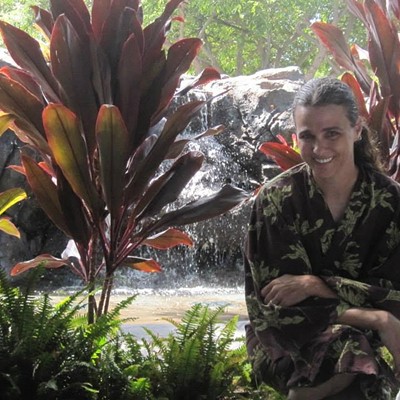"The installations fall into our interest in architecture and design at SMoCA," says Marilu Knode, interior curator of the exhibition. "These are objects that challenge our connections to them. For example, there are lights that only come on when it's quiet or really loud. They're called the Social and Anti-Social Lights."
Other pieces include Nucleo's Terra: The Grass Arm Chair, which is seeded, watered, and grown into shape (after all, why buy furniture if you can farm it?); Thomas Bernstrand's do swing, which hangs from the ceiling and functions as both light and a pulley-type exercise swing; and felt squares designed by the Danish firm Fortune Cookies, which the user can assemble and customize into garments (pictured).
The modernist maxim "form follows function" gets theoretically mashed by the designers' desire to redefine objects and their purposes.
"There's a new category for flexible housing," Knode says. "This is housing that responds to a more mobile society, and can also be used by people in emergency or disaster situations."
Progressive nomads can celebrate objects like Martin Ruiz de Azua's Basic House, a pocket-size polyester cube that inflates to a full-size abode with very little breath, and Markku Hedman's Summer Container, a mobile cabin packed into a matchbox.
"The project brings together designers who critique the objects we use," Knode adds. "Artists have been doing that for centuries, but we haven't seen that level of critique in the design field."
One piece, titled The Buildings of Disaster, critiques not only architectural design, but the celebration of structural icons connected with tragic events. The piece consists of pewter models of buildings like the Alfred P. Murrah Federal Building in Oklahoma City (target of the 1995 bombing), the Texas Book Depository, the World Trade Center, and the Three Mile Island nuclear power plant.
"[The piece] is really anti-monument," Knode says. "It's commemorating historical buildings, but not celebrating them the way we usually do."
But the unconventional pieces, according to Knode, encompass more than just a sense of cultural misinterpretation and impending doom. "The objects are beautiful, graphic, and engaging," she adds. "And there's a sense of humor in some of the objects, too."
The exhibition originated at the Walker Art Center in June 2003, and has since made stops at the Carnegie Museum of Art in Pittsburgh, and the "Lille 2004: Cultural Capital of Europe" festival in France. Andrew Blauvelt of the Walker Art Center continues to curate the exhibition, which has been called one of the top 40 exhibitions in the world by Artforum.











